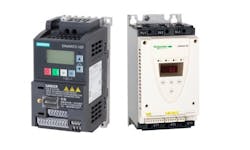When it comes to making decisions among various automation technologies to perform a task, the answer is rarely clear cut. Ultimately, the decision is often tied to the specifics of the application rather than which technology is perceived as being better. And so it is with the decision between soft starters and variable frequency drives (VFDs) to control a motor. Both technologies are viable choices—the decision depends on the application.
To learn more about making the decision between these two technologies, we connected with Jacob Becker, system solution architect at system integrator Tri Tech Automation, for a recent episode of the “Automation World Gets Your Questions Answered” podcast.
Becker outlined the basics of soft starter and VFD technology to begin our discussion.
Essentially, a soft starter is a motor control device that uses SCRs (silicon control rectifiers)—which are basically solid-state relays positioned back-to-back—to reduce the current delivered to a motor, enabling the motor to be started slowly and in a controlled fashion. “The time that the slowness of start takes place is configurable, as is the reduction in the voltage,” said Becker, “But it allows the motor to start up slowly and gently reduce stress on mechanical pieces.”
VFDs are a more complex motor control device that enable a motor to be controlled continuously at a specified speed. “A VFD takes the incoming AC power and rectifies it to a DC voltage,” Becker explained. “It then uses IGBTs (insulated-gate bipolar transistors) to take that DC voltage and invert it into a square wave waveform that simulates an alternating current. With that simulated waveform, the frequency of the waveform can be modified to change the speed of the motor.”
Efficiency differences
With more manufacturers looking to make their operations more sustainable and reduce energy costs, overall efficiency is an increasingly important consideration when making the decision between a soft starter or a VFD. On one hand, the precise control offered by VFDs can have a significant impact on efficiencies and costs. But soft starters also help reduce motor energy use.
Looking at the overall operation characteristics of the two devices, soft starters often edge out VFDs in terms of operating efficiency, though just by a couple of percentage points. Considering that, which one is likely to be the more efficient energy choice overall?
“If you have a motor that you know you're going to run at a fixed speed all the time, the soft starter is the clear answer simply due to the fact that a lot of soft starters have bypass contactors meaning that, once the motor is up to speed, the soft starter’s components will shut down and not use any more power,” said Becker. “So there's no efficiency loss. In such applications, the only time the soft starter is active is during the startup and shutdown of the motor.”
VFDs can be more efficient in applications where you need to start up a motor and run it at full speed for a period of time. But then, during a low-load application, you can reduce the speed of that motor but still have the VFDs operating to adjust speed as needed. In such cases, VFDs are more efficient.
In either case, Becker noted that both devices are extremely efficient.
Application decisions
Given the high efficiency of soft starters and VFDs, we asked Becker to provide some advice around industrial applications which typically use one of these technologies over the other.
“Soft starters are great for conveyor belts,” said Becker. “Especially if you need to start a belt moving but don't want things on the belt to fall over, soft starters are great for that. I've also seen a lot of soft starters used on screw compressors for refrigeration, because they slowly ramp the screws up. And the same idea can be applied to pumps that are going to run at full speed all the time to mitigate water hammer (pressure surges cause by fluids in motion).”
VFDs tend to be preferable to soft starters until you get to a certain motor size, said Becker.
“VFDs can be quite a bit more expensive when you get to a larger size motor,” he said. “But for 50 hp motors and below, we typically recommend VFDs instead of soft starters.”
With regard to applications for which VFDs tend to be better suited, Becker said, “Any kind of a pumping application where you want to modulate flow but you don't want to put a control valve in, that's a great spot for a VFD. Also, on smaller conveyor belts where you need to modulate the speed on a packaging line, for example, to allow for better handling of accumulation or equipment shutdowns.”
Leaders relevant to this article:



